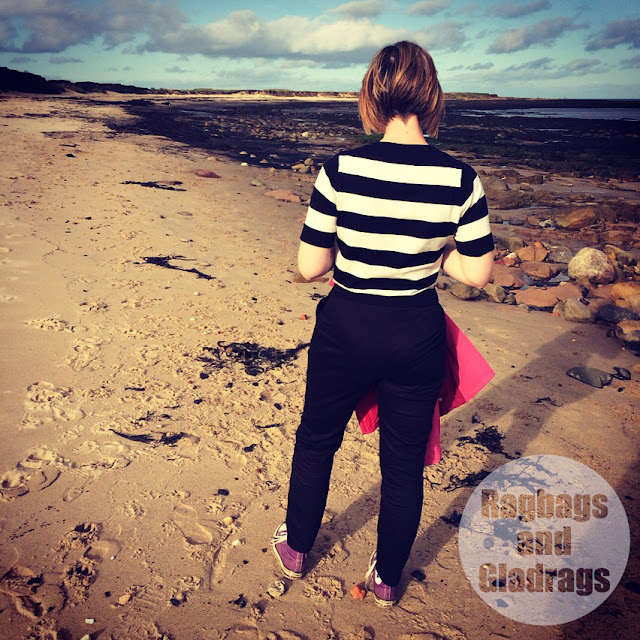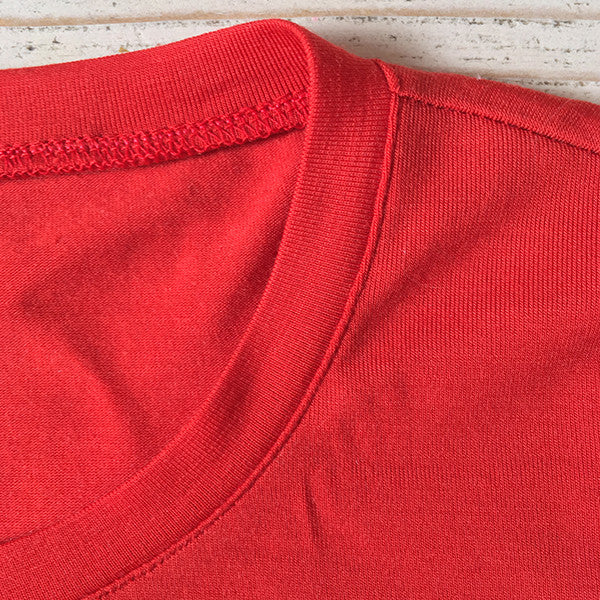 |
| SOI Eve dress - All the spots. I love this one |
I began sewing back in 2011 as part of my recovery from a stress-related illness. At the time it was one of two creative outlets I had, one was my art and the other was sewing. I sewed to make things that fitted and helped me feel good about myself. I really needed a sense of accomplishment.
 |
| My first make |
Over the last few years, I continue to sew to make things that fit and I know that my self-image and esteem has improved as I no longer feel the need to fit into the box that the world would have me believe is in 'Fashion' or 'Style'. As a beginner sewist, I made simple clothes in nice fabrics and I have challenged myself to try more challenging things. However, recently I have felt uncomfortable that the sewing world is becoming just like a high street shop - just with better made and fitted clothes. I see the same patterns again and again as each new indie pattern gets an outing. Does every sewer in blogland own a Keilo Wrap dress, Ogden Cami, Kalle Shirt, Ginger Jeans or Lander pants, to name but a few!!!!!
 |
| I love this dress and I still wear it - even if it's a bit faded |
Don't get me wrong - these are all great patterns (and I have a couple of them) and that's why they are popular. I thought quite a lot about buying the Ogden Cami and the Kalle shirt but have made my mind up that I don't want to jump on that bandwagon. I like the designs, sure I do, but they're not really me and I have other patterns that are similar but don't get as much airtime as these patterns. I still love the Colette Sorbetto and I hardly ever see it made in blog land these days. It's actually my go-to sleeveless top and I love it.
 |
| Eyelet Sorbetto top - still in rotation. |
I think the point I'm trying to make is that we consume pattern after pattern and make constantly - whatever is the next new sewing thing. The stash of fabrics increases and we create boatloads of waste pieces. I'm as guilty of this as the next person and I'm trying to fight against it. So I cancelled my subscription to Burdastyle Magazine - I have 6 years worth of magazines - more than enough to keep me going for a wee while. I also don't buy a pattern as soon as I see it. I like to consider if it's really me and if it's something I'll actually wear or I can make for others and I'll make more than once. Recently this means I didn't buy a pattern, which I really did like and now need to source as it's a foreign company and not easy to get here. Procrastination does bite me sometimes.
 |
| Pigs might fly - same style lines again. great print. |
 |
| Big bold prints |
I'm also more considered about the fabric I buy. I make a lot fewer trips to the cheap fabric stall on the local market and I buy less synthetic fabric than I used to; I take time over my makes (when I rush they go wrong anyway); I try to use patterns that I already own; I piece my scraps at the end of a project to make patchwork yardage - I'll be using these for some zero waste projects over the coming months. I'm trying to upcycle pieces that are a little unloved (i've just finished a Cambie dress refashion) and I'm trying to make only what I'll wear or make for other people.
 |
| A bold print and a full skirt |
Then there's the other thing - Style. My style has changed a bit and I do sew more basics than I used to as I wear nearly all me-made clothes. However, I have an aesthetic I'm drawn towards, yet I find myself making things I just won't wear or that actually don't fit my style. I also make far too many occasion wear pieces and don't wear them very often.
 |
| One of my many party dresses - I've worn this twice, but love it. |
This summer I've also found myself wearing slobby clothes, combat shorts and t-shirts - nothing wrong with that, but it's actually not my style.
I'm determined to identify shapes that work for me, colours that work for me and be willing to embrace the slightly odd side of my character a little more. After all, I'm an Art teacher I can get away with it.
 |
| I always get lots of compliments when I wear this one - It might be black but I love the style, nipped in waist and full skirt. |
So here goes:
Dresses/ skirts - Fitted waist with either a full skirt or pencil skirt at knee/ midi length. Shift dresses Knee length.
 |
| The dress that nearly didn't make it. the fit was off and I lost patience with it. |
Trousers - cigarette pants or wide-legged trousers - 50's style. Shorts not shorter than mid-thigh, culotte styles work well.
 |
| cigarette trousers - still need to perfect the fit. |
Tops - boat neck, jewel neck or shirt neck. T-shirts, fitted with a curved hem, short or 3/4 sleeves. Sleeveless shirts and tops that can be layered or cap sleeves/ extended shoulders.
Knitwear - cardigans - lots, waist length, semi-fitted and 3/4 to full sleeves.
Casual - jeans - skinny or bootcut, mid to high rise. Hoody tops/ tunics. Black leggings.
Accessories - Tights - as many different colours/ patterns as I can find - opaque; Jewellery - chunky and bright; scarves;
Footwear - mid-height Mary Jane style shoes - Bright colours. Flat ballerinas. Doc Marten boots - the chunkier the better. Converse all stars or similar.
 |
| Summer - it doesn't get much wear but I love it. Self-drafted. |
Fabrics - natural where possible; bright or black; unusual prints; no ditsy/ chintzy type prints; All the spots - every time. I try an avoid neutral colours except for black and white. and my colour palette is "spring" so most pinks and blues look good on me along with some greens. I have to be careful with reds near my face and orange is a no go unless it's part of a design with other colours.
In light of my list, I need to have a wardrobe clear out - time for a clothes swap.
 |
| Another Sorbetto top and this summer's winner - Burdastyle culottes with fabric gifted to me by a friend. |









